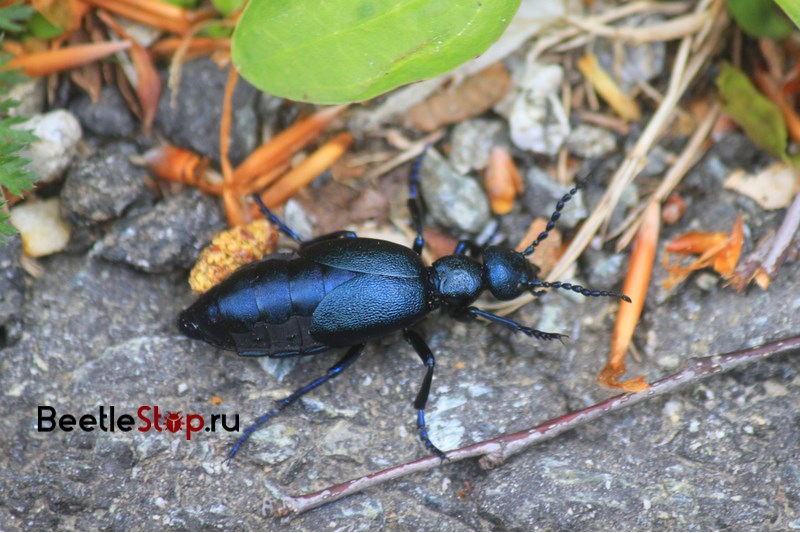Purple beetle - a poisonous insect that does not threaten anyone
T-shirts - a genus of bugs, plagues, differing in medium and large sizes. The body of insects is elongated, abdomen well developed, elytra shortened. A characteristic feature of the abscesses is the content in the body of the toxic substance cantharidin. At the time of the predators' attack, they secrete fluid from the joints of the limbs that causes skin abscesses. Among the most famous species are the common T-shirt (black), the colorful T-shirt (beautiful) and the purple beetle. Typical representatives of the genus feed on herbaceous plants, and their offspring parasitizes in bee nests. Insects with a shiny blue cover of the body with their coloring warns others about the danger.

Morphological description of the species
T-shirt purple or blue (Meloe violaceus) beetle from the family Nairniki, genus T-shirts. The adults are medium sized, body length is 10-32 mm. Head and pronotum covered with fine punctures. Elytra short, diverging to the sides. Representatives of the species do not fly, they do not have wings. The head is triangular in shape, the antennae are clear-shaped, the eyes are kidney-shaped. The abdomen is large, the female is especially swollen. Body color is dark blue, purple. Extremities with tenacious claws and spurs on the legs.
Information. Sexual dimorphism is expressed in the size of beetles (the female is larger than the male) and the shape of the antennae. In males, the clear-shaped antennas have bizarre growths in the middle.
Distribution area
Purple beetle bugs are found in Central and Southern Europe. Insects are common in Kazakhstan, East Asia, Iran, Afghanistan and North Africa. In Russia, they live in the Caucasus, Siberia and the Primorsky Territory.
Imago lifestyle
Awkward insects with a thick body stick to the ground, crawl along stumps and grassy plants. Adults eat cereals, like clover, dandelions, buttercups, anemones, violets. Caught nearby fields with vegetables, they harm crops. You can meet beetles in various biotypes: steppes, meadows, forest edges. To continue the life cycle, it is important that there are a number of open places suitable for single bees to settle.
Information. On a hot day, beetles hide under the leaves, a soft abdomen is buried in the ground to avoid drying out.
Adults appear in spring, in April. After additional nutrition, mating is started. Beetles are slow and slow, they do not run away from danger. Their hemolymph contains the highly toxic substance cantharidin, which can kill a small animal. Upon contact with human skin, an oily liquid causes an allergic reaction, blisters appear.
Interesting fact. In case of danger, the purple shirt falls to the ground and pretends to be dead. An additional protection mechanism is an oily, unpleasantly smelling liquid secreted from the joints of the limbs and abdomen.
In regions where the area of meadows is reduced, there is development, plowing, mowing grass, the number of purple shirts is reduced. Due to the lack of wings, beetles cannot travel long distances in search of new habitats.
Breeding
Mating is the final life of the males, passing the seed to the female, they die.For masonry, a place is chosen near the colony of solitary bees. Female digs mink in soft soil. In one clutch, the number of eggs reaches 1000 pieces. The female makes 2-3 separate minks with eggs. After that, she dies. Larvae appear after 30-40 days.
Hypermetamorphosis is characteristic of the family of navigator. This type of insect development is a transition between complete and incomplete metamorphosis. Larvae of T-shirts of the first age, called triungulins, differ from representatives of older ages. External differences are related to lifestyle. Triungulins are actively moving, looking for hosts for further development. Once in the nest of a bee, they molt and turn into short-legged vermiform parasites that feed on honey. Before true pupation, insects go through the “false pupa” stage.
Features of the development of larvae
Larvae of the first age, after leaving the earthen mink, climb flowering plants where they expect bees. They cling to hymenopteran insects that transfer larvae to their own nest. Once in the dwelling of a bee, the first thing they eat is an egg. Larvae grow and develop due to food reserves prepared in the nest. Solitary bees of common genera become osmosis victims: osmia, anthophores, and nomii. They build nests and lay eggs in the ground. Violet T-shirts live nearby, the development of which is impossible without owners.
The body of the triungulins is flat, yellow, size 1.7-2 mm. On the head are pointed sickle-shaped jaws, there are eyes. Abdomen ends with two long setae. The legs are long, with sharp claws on the paws, allowing to stay on the bee's body. After molting, the legs are shortened, and the eyes disappear. The larva eats stocks of honey, grows and molts several times. Some parasites pupate in the bee’s nest, but most leave it and dig into the ground to a depth of 10 cm.
By autumn, the larva turns into a “false pupa”, which is distinguished by a strong chitinous cover. In this state, she does not feed, falls into the winter diapause. The dense cocoon protects against drying out, climatic influences and mechanical damage. In spring, a larva emerges from it, turning into a chrysalis. A few days later, an imago emerges from it.
Apiary Pests
Sometimes triungulins cling to the hairs on the body of honey bees and fly into the hive. Together with other species (the common and motley T-shirt), the larvae parasitize on the body of the hymenoptera. During the mass exit of triungulin from the nests, the inhabitants of apiaries are at risk. Parasitism causes a disease - meleosis. Bees get rid of pests by fumigating with shaggy smoke. Larvae in hives do not develop, do not turn into a chrysalis and imago.

